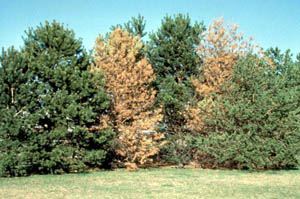Pine Wilt Watch
May 29, 2007
Pine wilt is a disease caused by pinewood nematodes (Bursaphelenchus xylophilus). The microscopic nematode is found in the wood of the tree. It plugs up the resin canal system in the host. These nematodes reproduce rapidly in the resin canals, damaging the resin canal cells and disrupting resin flow. The water-transport system becomes clogged, as with Dutch elm disease or oak wilt. The difference is that pine wilt is caused by a nematode, the others are caused by fungi.
Pine wilt symptoms to watch for at this time include gray–green foliage or needles that appear dull, off color. The tree will not improve. Instead, as the summer progresses, the foliage will turn yellow and then brown and remain attached for a long time. Trees that were infected last fall may not develop any new growth this spring. Although eventually the entire tree will be affected, initial symptoms may appear on one branch or area of the tree.
Many other problems can mimic this disease. Any factor that stresses roots, trunk, or water movement in the tree could cause similar symptoms. Transplant shock on young trees may cause these symptoms, as could drought stress or injury to roots by compaction. Sometimes chemical injury causes similar symptoms.
Pine wilt occurs on any of the pines we grow in Illinois except for white pine. Even that species may become infested after it has succumbed to other problems. In general, though, we do not see white pines infested with pinewood nematodes. Scotch and Austrian pines seem to be the common hosts in Illinois, but they are also the most commonly grown in our state.
There is no cure for a tree infested with pinewood nematodes. As soon as possible after a confirmation of pine wilt, the infested tree should be removed and burned or buried. The nematodes move from an infested tree to a healthy tree only on or in the vector, a sawyer beetle in the Monochamus species. This is why you may observe only one infested tree in a row of healthy pines, as in the image.

Wood can be assayed in about 24 hours for the presence of this nematode. The Plant Clinic at the University of Illinois offers this service. Send wood from the suspect tree. Branch sections 8 to 10 inches long and 2 inches in diameter are ideal. The branches chosen should have brown needles that are still attached. These are the areas of the tree most likely to be infested. As a note, trees with pine wilt usually have very little sap flow, so the wood seems dry. In addition, the blue stain fungus quickly moves into wood of infested trees. For more information on pine wilt, consult Report on Plant Disease, no. 1104, "Pine Wilt Disease" (Adobe PDF), or in most Extension offices. Information on submitting samples to the Plant Clinic can be found at http://plantclinic.cropsci.uiuc.edu/.
Author: Nancy Pataky
